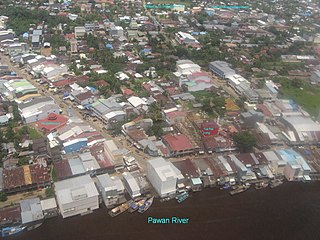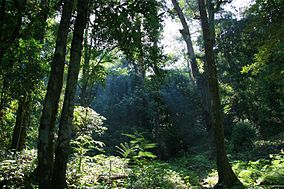
The proboscis monkey or long-nosed monkey, known as the bekantan in Indonesia, is a reddish-brown arboreal Old World monkey with an unusually large nose. It is endemic to the southeast Asian island of Borneo.

Gunung Leuser National Park is a national park covering 7,927 km2 in northern Sumatra, Indonesia, straddling the border of North Sumatra and Aceh provinces, a fourth portion and three-fourths portion, respectively. The national park, settled in the Barisan mountain range, is named after Mount Leuser (3,119 m), and protects a wide range of ecosystems. An orangutan sanctuary at Bukit Lawang is located within the park. Together with Bukit Barisan Selatan and Kerinci Seblat National Parks, it forms a World Heritage Site, the Tropical Rainforest Heritage of Sumatra.
The gray tree rat is a species of rodent in the family Muridae and the only species in the monotypic genus Lenothrix. It is found in forests in Indonesia and Malaysia. A common species, the IUCN has rated it as being of "least concern".
The Australian Orangutan Project t/a The Orangutan Project (TOP) is a non-profit registered Australian environmental organisation established in 1998, which raises funds to support the conservation and protection of orangutans and the preservation and rehabilitation of their forest habitats, which are primarily located in Indonesia. It undertakes this work by supporting a range of other organisations working in the field, such as the Borneo Orangutan Survival Foundation (BOS), the Orangutan Foundation International, founded by Dr Birute Galdikas and the Orangutan Foundation.

Betung Kerihun National Park is a national park in the province of West Kalimantan on the island of Borneo, Indonesia. It is located inland, along the Malaysian border. The park was established in 1995, and has a total area of 8,000 km2 (3,100 sq mi) or about 5.5 percent of West Kalimantan Province area. Together with the 2,000 km2 (800 sq mi) Lanjak Entimau Wildlife Sanctuary in Malaysia, it has been proposed to form a World Heritage Site named the "Transborder Rainforest Heritage of Borneo".

Ketapang or Tau-pang in Teochew is the capital city of Ketapang Regency, one of the regencies of West Kalimantan province on the island of Borneo in Indonesia. Ketapang city is located at 1°51′S109°59′E and is a small city on the delta of the Pawan River. Ketapang is served by the Ketapang Airport.

Sabangau National Park is a national park in Central Kalimantan, a province of Indonesia in Kalimantan, the Indonesian part of the island of Borneo established in 2004. Between 1980 and 1995 the site was a massive logging concessions area. After 1995, the park became a site for illegal logging, which resulted in up to 85 percent of the 568,700-hectare total park area being destroyed. By 2012, less than 1 percent of the park's total area has been reforested and several centuries is needed to restore it to its pre-logged state.

The Borneo Orangutan Survival (BOS) Foundation is an Indonesian non-profit NGO founded by Dr Willie Smits in 1991 and dedicated to the conservation of the endangered Bornean orangutan and its habitat through the involvement of local people. It is audited by a multinational auditor company and operates under the formal agreement with the Indonesian Ministry of Forest to conserve and rehabilitate orangutans. BOS manages orangutan rescue, rehabilitation and re-introduction programmes in East and Central Kalimantan. With 804 orangutans in its care and employing between six hundred and a thousand people at a hundred sites BOS is the biggest primate conservation NGO worldwide.
Lone Drøscher Nielsen is a Danish wildlife conservationist who established the Nyaru Menteng Orangutan Reintroduction Project in Kalimantan, Borneo, Indonesia in 1998.

Borneo lowland rain forest is an ecoregion, within the tropical and subtropical moist broadleaf forests biome, of the large island of Borneo in Southeast Asia. It supports approximately 10,000 plant species, 380 bird species and several mammal species. The Borneo lowland rain forest is diminishing due to logging, hunting and conversion to commercial land use.

Tanjung Puting National Park is a national park in Indonesia located in the southeast part of West Kotawaringin Regency in the Indonesian province of Central Kalimantan. The nearest main town is the capital of the Regency, Pangkalan Bun. The park is famous for its orangutan conservation.

Willie Smits is a trained forester, a microbiologist, conservationist, animal rights activist, wilderness engineer and social entrepreneur. He has lived in Borneo since 1985 and is an Indonesian citizen.

Deforestation in Borneo has taken place on an industrial scale since the 1960s. Borneo, the third largest island in the world, divided between Indonesia, Malaysia and Brunei, was once covered by dense tropical and subtropical rainforests.

Samboja Lestari is an area of restored tropical rainforest near the city of Balikpapan in East Kalimantan, Borneo, Indonesia, created by the Borneo Orangutan Survival Foundation (BOS) led by Dr Willie Smits, with the aim of providing a safe haven for rehabilitated orangutans while at the same time providing a source of income for local people. According to Smits' talks for Qi Global and TED, Samboja Lestari has evolved on the principles of People, Planet, Profit, linking community and empowerment and capacity-building with promoting economic development and conservation. Located about 38 kilometers from East Kalimantan's biggest city, Balikpapan, and 87 kilometer from its capital, Samarinda.
The Sunda Shelf mangroves ecoregion, in the mangrove biome, are on the coasts of the islands of Borneo and eastern Sumatra in Malaysia and Indonesia. They are home to the proboscis monkey.

Pawan River is a major river of West Kalimantan, Indonesia. It has a length of 197 kilometres (122 mi). Tributaries include the Keriau River.

North Kayong Regency is a regency of West Kalimantan province in Indonesia. It covers an area of 4,568.26 km2, and had a population of 95,594 at the 2010 Census; the latest official estimate is 98,866. The principal town lies in Sukadana. The nearest airport is Ketapang Airport.

Sukadana is the capital city of North Kayong Regency, on the island of Borneo. North Kayong regency is one of the regencies of West Kalimantan province in Indonesia. The nearest airport is Rahadi Osman-Ketapang Ketapang Airport.
Panti, Rory O'Neill, is an Irish drag queen and gay rights activist























